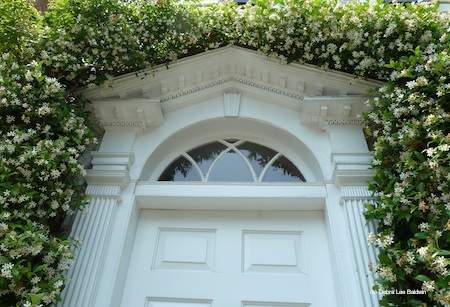
This time of year, South Carolina’s warm, moist air is fragrant with Confederate (star) jasmine, above, and robust gardenias like those in the garden below. I was there recently to address the Charleston Horticultural Society (CHS) on my specialty, designing with succulents. Naturally I wondered if I’d see any.
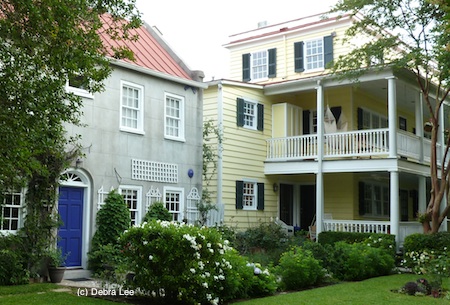
The CHS arranged for me to stay in a historic downtown Charleston “single” — a house that’s one room wide, not including its palazzos (porches). As you can see, Katie Roberts—who put me up and put up with me—painted the door of her home’s former coach house morning-glory purple. My kind of gal.
CHS members Jackie Joye, Patti McGee and Beverly Gumb graciously took me to gardens and nurseries. These lovely Southern ladies and I bonded thanks to our mutual passion for plants.
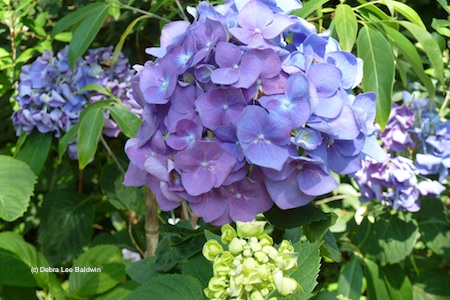
In addition to making it possible to grow glorious camellias, azaleas and gardenias, the Low Country’s acidic soil turns hydrangeas blue. Naturally, because it’s hard to grow them, residents want pink hydrangeas.
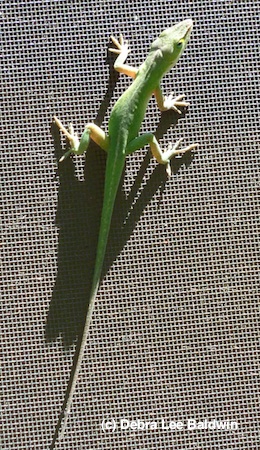
My garden has alkaline soil (I covet blue hydrangeas) and brown-gray lizards. Charleston gardens are bejeweled with chameleons. They really do change color depending on what they’re sitting on. [Corrected below. — DLB]
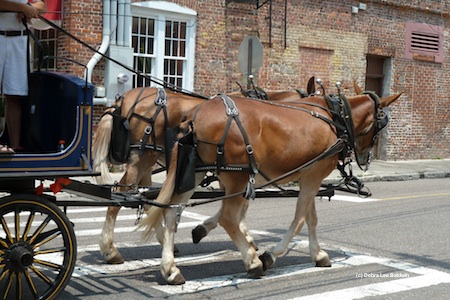
Here’s something else you don’t see in Southern CA (except in theme parks).

Or “tabby”: pavement with an aggregate of shells.
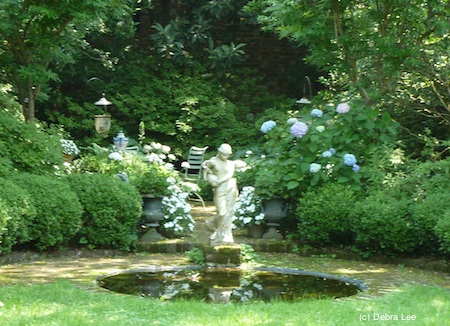
The garden of Charleston artist and lifelong resident Marty Whaley Adams Cornwell graces a pre-Revolutionary-War house on Church Street built by Thomas Heyward, a signer of the Declaration of Independence. Famed landscape architect Loutrel Briggs designed the garden 70 years ago. Depending on your vantage point, a shallow pool reflects a classical statue, the sky and/or the surrounding garden.
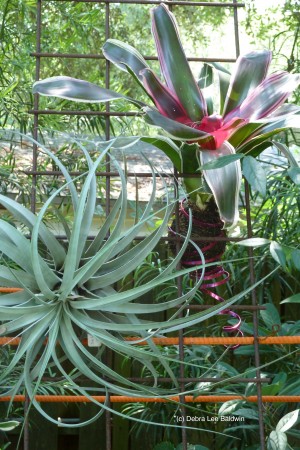
Jim Martin, executive director of the Charleston Parks Conservancy, a nonprofit organization dedicated to beautifying and preserving the city’s many public parks, is not shy about color in his own garden. A whimsical spiral of pink echoes a bromeliad’s color and the ribbon-like leaves of Agave bracteosa. (A succulent!)
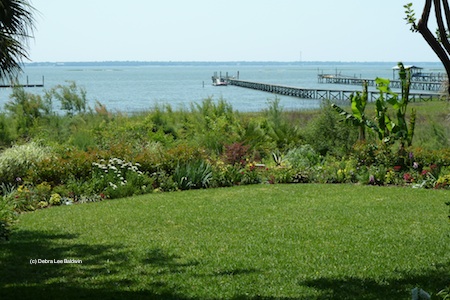
Several of the gardens I visited, like Mollie Fair’s (above), had impressive water views and were bordered by marshland. See those leaves that stand out, in the perennial border to the right of center? Agave americana medio-picta ‘Alba’!
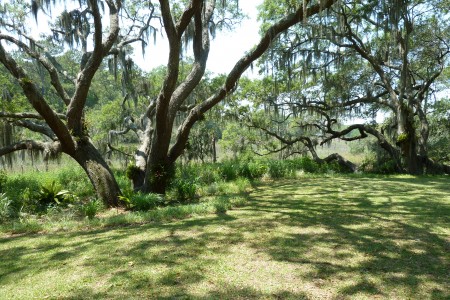
Immense oaks dripped with Spanish moss, a kind of tillandsia (air plant). “Don’t touch it,” cautioned Beverly, a split second too late. “Red bugs.” Also known as chiggers, these microscopic insects literally get under your skin. Although none came aboard, just finding out about them made me itch.
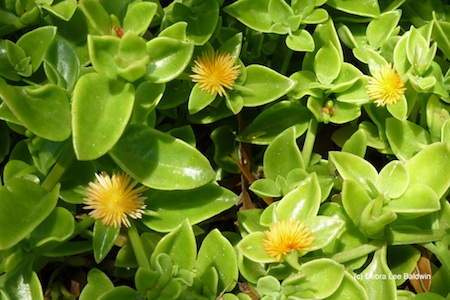
Also new to me was a red apple ice plant (Aptenia cordifolia) with yellow flowers. A succulent-savvy friend later ID’d it as Aptenia haekeliana.
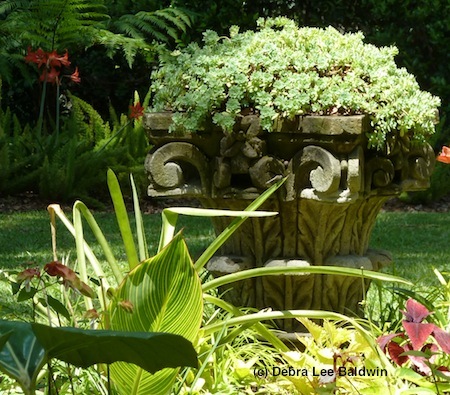
Sedum cascaded from a pedestal pot in the garden of Jim Smeal and Alejandro Gonzales. As Alejandro gestured to coleus, bromeliads and amaryllis, he explained that he loves the color coral.
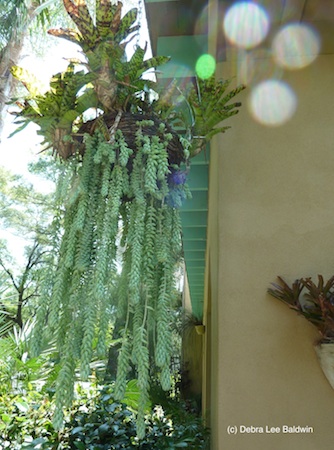
Beneath the home’s eaves, another succulent, donkey tail (Sedum morganianum), shared a hanging basket with a mottled bromeliad.
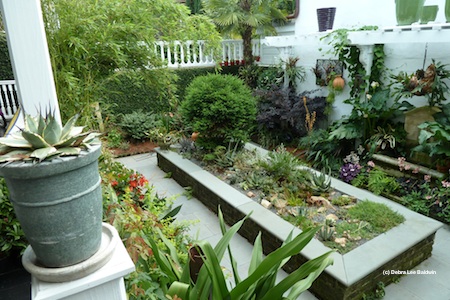
In her downtown Charleston garden, plantswoman/horticulturist Linda Guy grows cacti and succulents in pots and in a long, rectangular raised bed. Doubtless she makes sure the soil is extremely well-drained. Charleston may get as much as 55 inches of rainfall a year. By comparison, my home town of Escondido (in that epicenter of succulents, Southern CA) typically gets fewer than 15.
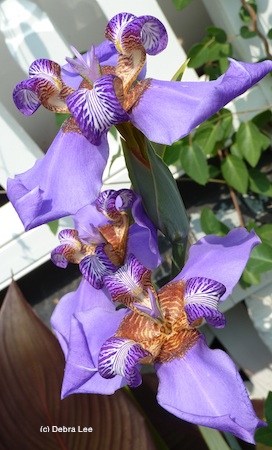
In Linda’s garden was a bearded iris that resembled an orchid. Her business, Plants Nouveau, specializes in great new introductions.

Also in Linda’s garden is this pretty, efficient and enviable potting area.
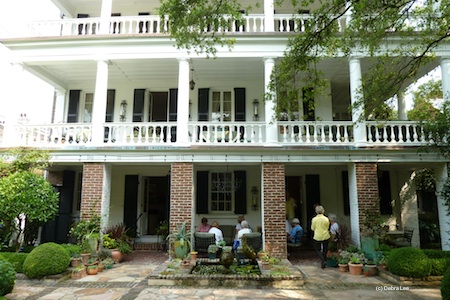
The morning after my CHS presentation, I gave an impromptu presentation to Patti’s garden club. She loves succulents and has an impressive collection in pots in her garden’s sunny areas.
Succulent sources for that region include Tony Avent’s Plant Delights nursery in Raleigh, North Carolina, and Lowe’s and Home Depot stores.
If you’ll be in the Charleston area, independent nurseries well worth visiting include:
Garden Wise Nursery & Garden Center (owned by John and Nora Wise), Johns Island
Hyams Garden & Accent Store, North Charleston. On staff is Sarah Petrowski, who has an impressive knowledge of succulents.
Sea Island Savory Herbs, Johns Island
And before you go (or while you’re there) be sure to read “Very Charleston: A Celebration of History, Culture and Lowcountry Charm,” written and illustrated by Diana Hollingsworth Gessler.

Yes, that’s Confederate jasmine. Just imagine the intensity of the fragrance!
